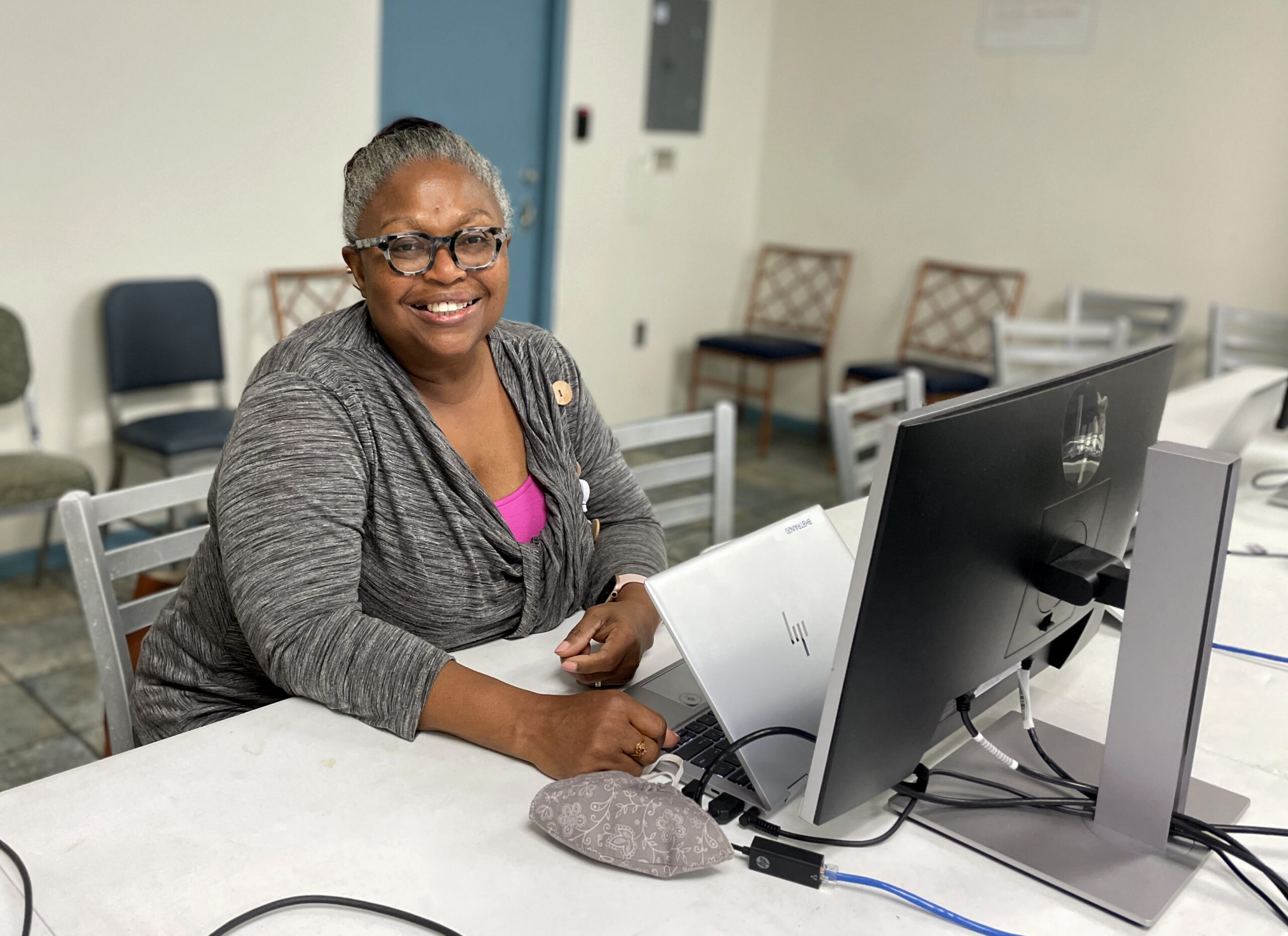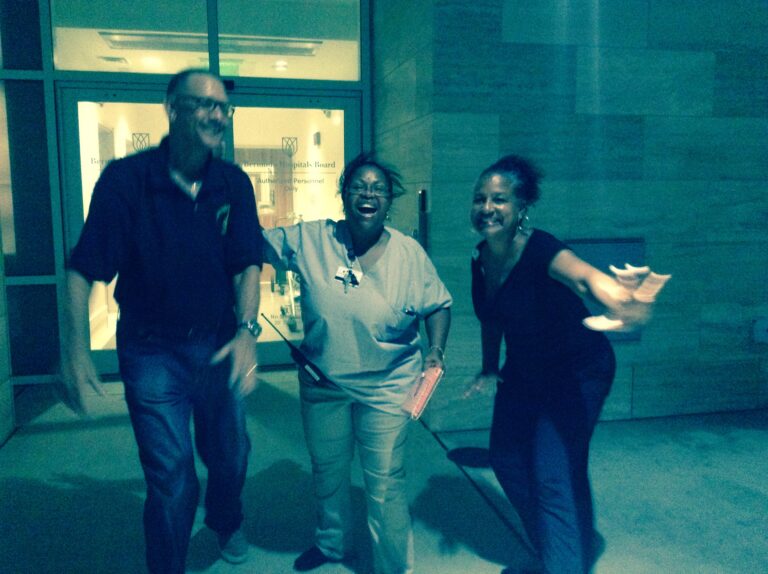by Tim Smith
In photo: Dr. Rosyln Bascombe-Adams (centre) braves major storm winds outside King Edward VII Memorial Hospital with colleagues Marshall Minors and Venetta Symonds
Major storms can be challenging in any building, but the stakes don’t get much higher than at a hospital.
For Dr. Roslyn Bascombe-Adams, the devastating threat of Mother Nature was perfectly illustrated when Hurricane Gonzalo battered King Edward VII Memorial Hospital (KEMH) in 2014. More than 50 patients had to be relocated in the middle of the storm after the roof started collapsing in the extended care wing.

“The manager called and said she was having water breach,” says Dr. Bascombe-Adams, the chair of the Disaster Management and Response Committee at Bermuda Hospitals Board (BHB).
“We walked towards that area. Water was coming in like a shower in some areas of the corridor and in a couple of the rooms. And so, we had to move patients during the storm.”
As luck would have it, the hospital’s general wing had been vacated shortly before the storm, meaning there was space for them to move into. “I would say that was heaven-sent in some way,” Dr. Bascombe-Adams says. “We just fortunately could move patients into the recently debunked general wing physical space. Everything was still working in those areas, and we were able to relocate.”
Many patients were suffering from dementia and did not understand what was happening. But Dr. Bascombe-Adams adds: “It would have been a very frightening experience for those who were aware.”
She says that incident highlighted why it is so important for the hospital to be meticulous with all its storm preparations. “This is the reason why big decision makers need to be there, to make those on-the-spot decisions. If communication is disrupted, we can’t have them making those decisions from home.”
Preparation begins at the start of hurricane season on June 1. “We ask that everyone goes through the basics of making sure that we have enough to keep the hospital up and running should we have an interruption of power, disturbance of water supply and anything that we need,” Dr. Bascombe-Adams says. “We urge all staff to brush up their storm plans to make sure they refresh their staff with what needs to be done at the departmental level.”
As the hospital’s representative on the Emergency Measures Organization (EMO), Dr. Bascombe-Adams gets regular updates from the Bermuda Weather Service as a storm approaches the island. The first task for staff is to ensure they are prepared on the home front. “If staff don’t have their families safe, it would be difficult to concentrate on rendering care of someone else,” she explains. “They have to make sure their home plans are fine and then their department plans are fine.”
Managers look out for any part of the building that might need attention in their department, and the Hospital Incident Command Centre (HICC) team is put together. “We usually have those who are going to brave the storm in-house come together,” Dr. Bascombe-Adams says. “We set up a command centre in one room deemed to be a safe room in the centre of the building, with access to emergency power.”
That group coordinates responses throughout the storm, making high-pressure judgement decisions on whether ambulances go out to emergency calls, depending on the movement of winds. “It’s our responsibility in the command centre to make sure that everyone who is acting on behalf of the BHB is doing it safely,” she says.
For major storms, two groups of staff are set up: one that will brave the storm, and the other that replaces them afterwards. Of course, depending on the length of the storm, those in the first group could be in for a long shift, rotating with colleagues and using office spaces as rest zones. Dr. Bascombe-Adams recalls: “Twenty-eight hours is the longest I’m aware of—during Fabian—because it disrupted roads for so long.”
Meanwhile at Mid-Atlantic Wellness Institute (MWI), a command post is set up to monitor the needs of the MWI campus and its 14 group homes via back-up radios. Dr. Bascombe-Adams says, “Should they need assistance during or after the storm and the phone lines are disrupted, there needs to be available communication options so that they can get those needs resolved or inform the command centre of relevant situations which arose and were resolved.
The MWI command centre liaises with the HICC at KEMH, so that the needs of all areas of the campuses are met in a timely manner. “The linkages with the group homes are crucial, as ultimately they are the responsibility of BHB. HICC is then able to relay reliable information of impact and needs to the EMO in a timely manner and have resources guided accordingly to resolve issues.”
Before the storm arrives, patients who may need care within the next 24 hours, such as those requiring dialysis or psychiatric treatment, are brought into hospital. Dr. Bascombe-Adams adds that anybody who is near to their delivery time, particularly if it’s a problem pregnancy, would be brought in-house to ride out the storm. Efforts are made to ensure anxiety among patients is kept to a minimum.
“The staff in the various departments have the responsibility of assuring patients. I think they do a fantastic job of that,” Dr. Bascombe-Adams says. “We are used to dealing with patients’ anxiety— that’s all just part of the job.”
The busiest period, of course, comes after the roads reopen and storm victims make their way to the emergency ward. Injuries are typically caused by falling debris, people stepping on broken objects, falling off ladders while they fix damage or handling tools they do not often use. Others include asthmatics who did not have their inhaler and people who ran out of medication.
Bermuda, however, copes much better than other countries in the aftermath of such storms.
“Our current method of preparation in Bermuda is viewed as one of the better ones in the region,” Dr. Bascombe-Adams says. “I have been on a journey of learning. Every storm is different and I learn more each time.”

